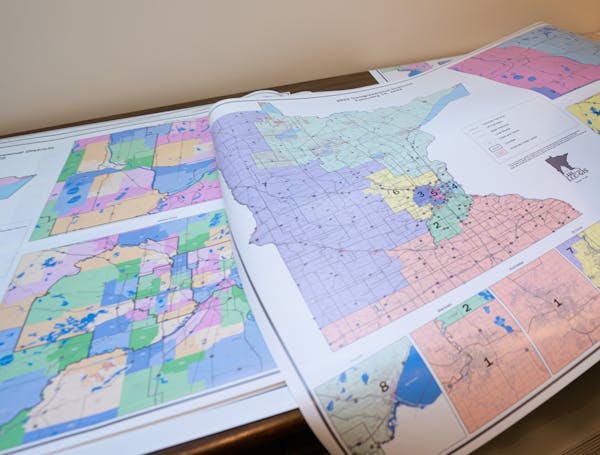State Sen. Mary Kunesh couldn't help but jump to her feet and do a "happy dance" when she saw Minnesota's new political boundaries.
The lines now zigged and zagged to encompass all seven of the state's Anishinaabe tribes in the northeastern eighth district in Congress, instead of splitting them between two seats. Where three tribes were once drawn into two state Senate seats, they were now in one.
After more than 100 years of being divided, the tribes asked the state courts to unite them in redistricting. The judges listened.
"Now when you look at the map and you see all those tribes in one district, that's a powerhouse," said Kunesh, DFL-New Brighton, one of four Native legislators currently serving at the state Capitol. "Minnesota is going to have to really start listening to the tribes."
It's a different scenario than what's playing out in states such as Nevada and North Dakota, where tribes are suing elected officials for drawing maps they say intentionally fractured the political power of tribal nations. In Minnesota, tribal leaders say the addition of new reservation lands and thousands of enrolled tribal members in the eighth has added pockets of deep blue voters in the conservative district while giving them more power over lobbying their member in Congress on issues important to the tribes.
"We have a chance to nominate a Native to Congress or Senate and we can endorse someone who can support tribal initiatives," said Red Lake Tribal Council Chairman Darrell Seki Sr. "If the tribes got all together, we could be a force."
It's been a long journey to get to this point, tribal leaders say. The division of the state's northern tribes dates back to at least the late 1800s, and it was just one of many struggles Indigenous citizens faced exercising their power at the polls.
Native Americans weren't granted citizenship until 1924, and many states continued to block their participation for decades. More recently, lack of education about voting rights, as well as limited polling locations and Internet access on rural reservation lands, have kept many Native citizens from getting out to vote.
But groups are starting to organize. In the last election, Native American voters turned out in record numbers in battleground states such as Arizona. In Minnesota, voter turnout increased on average nearly 20% in areas with high Native American populations, according to a Star Tribune analysis of voter data. In 51 Minnesota precincts where Native Americans make up at least a quarter of the electorate, the number of votes for president were up in all but three precincts.
And for the first time in a state redistricting cycle, communities of color, including the tribes, were represented in the redrawing of state's political maps, participating as interveners through the advocacy group Common Cause in a lawsuit asking the courts to take over the process.
Minnesota's divided Legislature has failed to agree on a set of congressional and legislative maps for the last five decades, kicking the process to the courts. The five-judge panel in Minnesota agreed to the tribes' position in their Feb. 15 maps, saying uniting them will "afford those tribes an opportunity to join their voices."
Cathy Chavers, the president of the Minnesota Chippewa Tribe, which covers six of the seven tribes in northern Minnesota, emphasized that each tribe is a sovereign nation, but they will be working together to speak with one voice on issues such as land use and the environment, as well as funding for housing, education and Native schools.
Tribal leaders met with current Eighth District Republican U.S. Rep. Pete Stauber after he was first elected in 2018. It was "a good discussion," Chavers said, but there are more issues they want to see eye-to-eye on. Stauber announced he's running for a third term in the new district.
"At least if we're at the table, we're at the table," Chavers said. "That's one thing the tribes are trying to reiterate to everyone, to have tribes at the table at the beginning. Not at the end, not at the middle — right away."
The leaders of several tribes criticized Stauber last year for not telling them in advance of his efforts to block the appointment of Deb Haaland, a tribal member, as President Joe Biden's pick for Interior secretary.
But uniting the tribes makes them a constituency that can't be ignored by any member of Congress in northern Minnesota going forward, said Tadd Johnson, director of American Indian Tribal Nations Relations at the University of Minnesota.
"It's kind of like the tribes have been clearing their throats for decades," he said. "Suddenly they have this voice."
It could also make Native candidates a force in elections, Johnson said. The new state Senate District 2, which includes reservation lands for the White Earth, Leech Lake and Red Lake Nations, has already drawn two Native candidates: Republican state Rep. Steve Green, a White Earth enrollee, and Alan Roy, a Democrat and White Earth Nation tribal leader.
Forty-three percent of voters in the new state Senate district voted for Biden last fall, a seven percentage point increase from the old lines, which excluded the populous Leech Lake reservation and stretched farther to the south.
Ernest Joseph Oppegaard-Peltier III, a citizen of the Turtle Mountain Band of Chippewa, was drawn into the new eighth district and has announced he's running against Stauber. The new district is still a likely conservative seat based on past voting results, but the new lines will be in place for the next decade, giving the tribes time to get organized.
"There's the conversation about what it means for 2022 and then there's the conversation on what it means for 2026 and 2028," said Rep. Jamie Becker-Finn, DFL-Roseville, a descendant of the Leech Lake Band of Ojibwe. "These are the maps for 10 years, so there's a real opportunity here to build engagement with communities that have been historically divided and disengaged."
